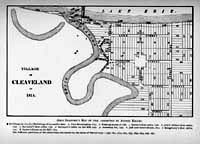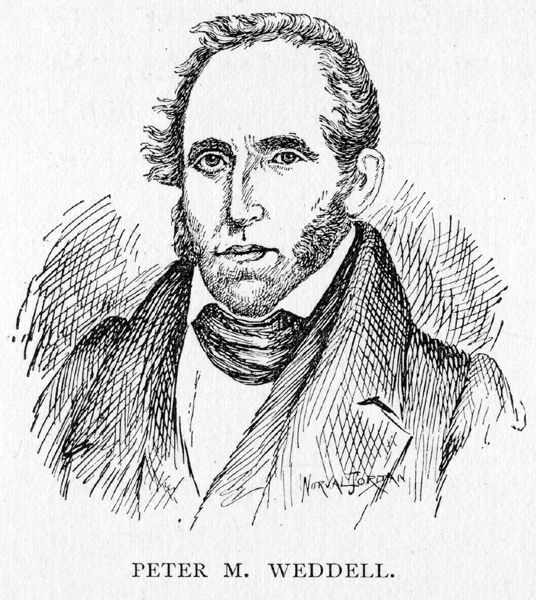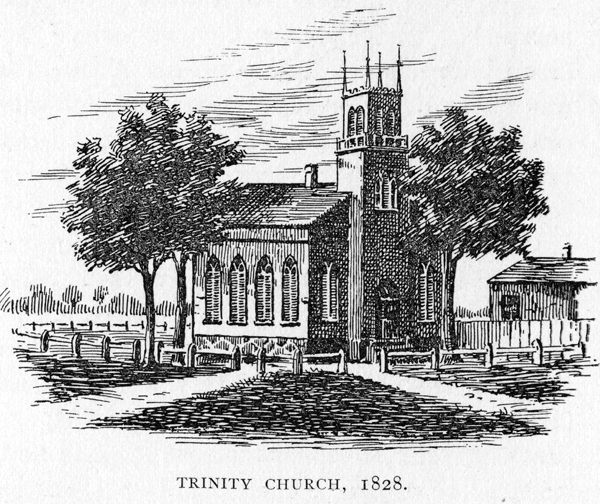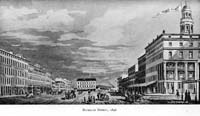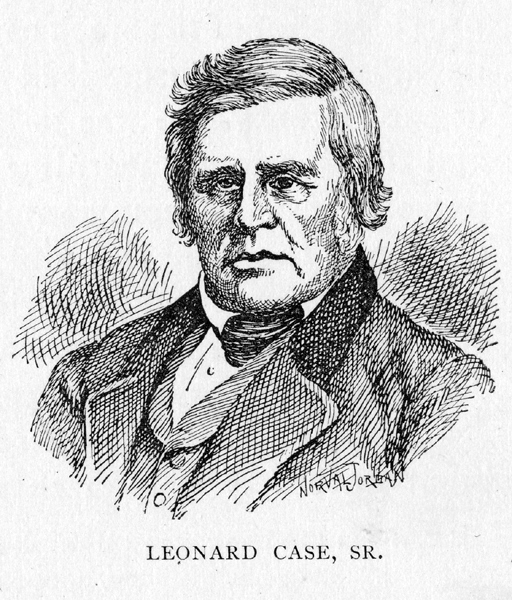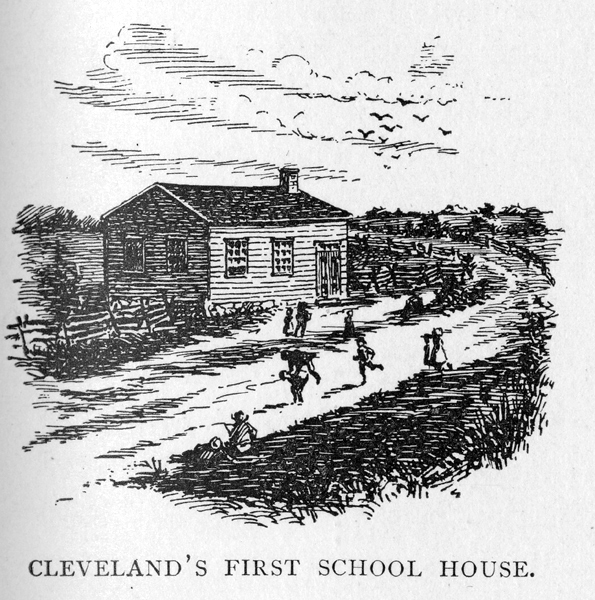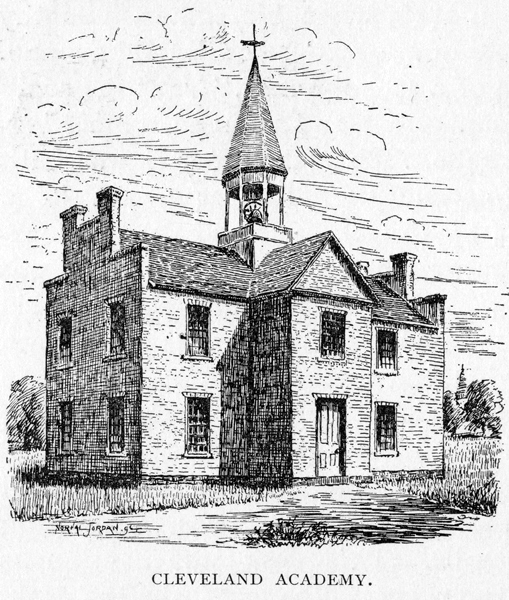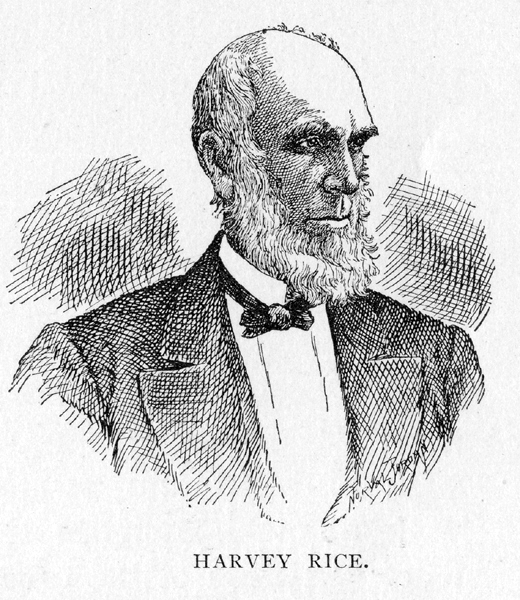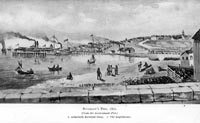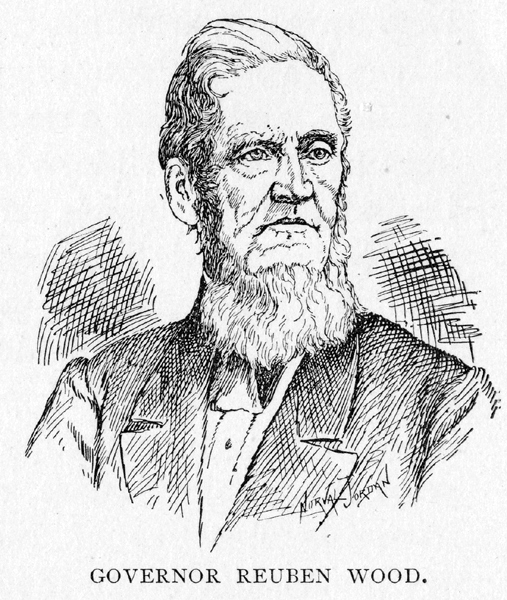|
CHAPTER VIII THE INCORPORATED VILLAGE OF CLEVLAND. The year 1814 was by no means one of moment in a local sense, although it saw Newburg set up as a township upon its own responsibility, and steps taken toward the incorporation of Cleveland as a village. Her claim to this distinction lay in the fact that she possessed a total of thirty-four dwelling houses and places o business�one of these being a brick store, the first of its kind, erected by J. R. and Irad Kelley. It was also becoming well known as a ship-building point, which fact was emphasized somewhat by the means taken by Levi Johnson to get his schooner "Pilot" down to the water. That he might be near his base of timber supplies, he laid the keel in the woods, on the Euclid road, near the present site of the Opera House, and when finished, found it necessary to drag it a half mile to the water. Unlike Robinson Crusoe, however, he had figured all the ways and means in advance. He sent for his friends in the country roundabout, and they came with their oxen, twenty-eight yoke in all, placed rollers under the structure, and soon had it safe and sound at the foot of Superior street, where it gracefully slid off into the water. Something was done in the way of schools, a little in advance of anything yet recorded. We find traces of several centers of pioneer teaching in the neighborhood, the most important of which was that kept by the Rev. Stephen Peets, who is remembered not so much because of his teaching, as from the fact that he gave an entertainment that stirred the entire social nature of the settlement. Mr. Morgan, to whose wonderful memory and vivid descriptions I already owe, so much, informs us that this event occurred at the log-house of Samuel Dille,125 "on the road from Newburg to Cleveland, now Broadway, where you first get a view of the river from the high land,� It was a large structure for those days, and had a spacious upper room, running the whole length and breadth of the house. "There," he adds, "the people of Newburg and Cleveland assembled and witnessed the performance of the �Conjurer� taken from the Columbian Orator; the �Dissipated Oxford Student,� also taken from the same book; �Brutus and Cassius,� taken from the American Preceptor; and several other pieces. The various parts were conceded by the critics there to have been performed in admirable style." He then gives us a pen-picture of some of the difficulties of pioneer travel: "After the performance, my father, mother, two sisters and myself returned home, a distance of a mile and a half on the family horse. Two adults and tree plump children, six to twelve years of age, might now be considered a rather large load to carry and five on a horse, as may be supposed, would now render a cavalcade somewhat uncouth in appearance of the street of Cleveland." The township of Newburg was organized on the 15th of October of this year, 1814, embracing within its limits the residences of a number of important citizens, among whom were James Kingsbury, Rodolphus Edwards, and Erastus Miles. A little over two months later, on December 23rd, Cleveland made a point against its rival, by securing from the general assembly the passage of an act "To incorporate the Village of Cleveland in the County of Cuyahoga." The boundaries of this new village were described as "so much of the city plat of Cleveland, in the township of Cleveland, and County of Cuyahoga, as lies northwardly of Huron street, so-called, and westwardly of Erie street, so-called, in said city plat as originally laid out by the Connecticut Land Company, according to the minutes and survey and map thereof in the office of the recorder of said County of Cuyahoga." Facing Page In accordance with this law, twelve of the male inhabitants of Cleveland met on the first Monday of June , 1815, and, by a unanimous vote, elevted Cleveland�s first village official staff, as follows: President: Alfred Kelley. Alfred Kelley held his position as Cleveland�s first President less than a year, when he resigned, and was succeeded by his father, Daniel Kelly, on March 19th, 1816; and at the annual meeting in June of that year, the latter was unanimously continued in the office, which he held until 1819. The elder Kelley was formerly a resident of Lowville, New York, and served as president judge of the Common Pleas Court of Lewis County; was one of the founders of Lowville Academy, and a useful citizen in many public ways. The office of president, from Mr. Kelley�s term in 1819 up to the adoption of the city charter and election of the first Mayor in 1836, was filled as follows: In 1820, Horace Perry was elected; Reuben Wood succeeding him in 1821. From the latter year until 1825, Leonard Case filled the position; but failing to qualify on his election in the year last named, the recorder, Eleazur Waterman, became president ex officio. There is a blank in the record-book from 1825 to 1828, and an examination of the files of the "Cleaveland Herald" for those years, fails to show that an election had been held. The probability is that Mr. Waterman continued to fill both the office of recorder and president until 1828, When he was compelled to resign because of ill-health, resulting from an accident. The next entry shows that on May 30th, the trustees appointed Oirson Cathan president, and D. H. Beardsley, recorder. Mr. Cathan was a well-known painter, and was married to a daughter of Lorenzo Carter. The office was then filled as follows: 1829, Dr. David Long; 1830 and 1831, Richard Hilliard; 1832, 1833, 1834 and 1835, John W. Allen. From the twelve votes cast for Mr. Kelley in 1815, Cleveland had grown to a total of one hundred and six votes for Mr. Allen in 1835. With the close of Mr. Allen�s term, the old regime came to an end, and Cleveland entered upon her career as a city. Returning now to the newly incorporated Village of Cleveland, we see the trustees holding a meeting in October (1815), at which a number of streets were laid out, on the petition of John A. Ackley, Aaron Olmstead, Daniel Kelley, Thompson Miller, Matthew Williamson, Amasa Bailey, William Trimble, Levi Johnson, Joseph R. Kelley, Stephen Dudley, John Randall, Hiram Hamter, and Ashbel W. Walworth. After the streets were designated by the numbers of the lots the record continues: "And it is further ordered the said several streets in said petition, mentioned and described, shall be severally distinguished, known and called by the following names, to-wit: The first, in said petition mentioned, shall be called �St. Clair Street,�� the second �Bank Street,� the third �Seneca Street,� the fourth �Wood Street,� the fifth �Bond Street,� the sixth, �Euclid Street,� the seventh, �Diamond Street.127�" In the January following, A. W. Walworth was appointed corporation clerk, and it was officially ordered that the "said clerk shall not issue any amount of bills greater than double the amount of the funds in his hands" The main points of village legislation up to 1836, may be briefly chronicled. In 1816, it was ordered that a tax of one half per cent. be laid on all the lots in the township; in 1817, that "the several sums of money which were by individuals subscribed for the building of a school-house, in said village, shall be refunded to the subscribers;" In June, 1818, the first recorded ordinance was passed, declaring that "if any person shall shoot or discharge any gun or any pistol within said village, such person so offending shall, upon conviction, be fined in any sum not exceeding five dollars, nor under fifty cents, for the use of said village," A number of ordinances were passed in 1820, among which the following may be enumerated: Forbidding swine running at large or butchering within the city limits, except under certain regulations; making it necessary to obtain the consent of the authorities before any show could be given; forbidding horse-racing and fast driving; making a penalty for the running of geese at large; and others of a like character. In 1823, an ordinance was passed regulating the planting of shade trees in the streets; in 1825, a tax of one-fourth per cent. Was laid on all village property, and a new enumeration of property given; in the same year, Canal, Michigan, a part of Seneca, and Champlain streets, were officially laid out; in 1828 a, a tax of two mills per dollar was ordered. Of course, all these things were not done without objection and grumbling from tax-payers, as human nature was the same sixty years ago that it is today. We find the following illustrative incident in a biography of the late N. E. Crittenden: "In his early days in Cleveland, he was chosen one of the village trustees. In 1828, when he held that office, and Richard Hilliard was president of the board, the members gathered one afternoon in an office and voted an appropriation of two hundred dollars, to put the village in proper order. Great was the outcry at this wastefulness, on the part of the taxpayers. One of the old citizens, who yet lives, met Mr. Crittenden and wanted to know what on earth the trustees could find in the village to spend two hundred dollars on." The year 1829 saw the purchase of Cleveland�s first fire engine. It was bought of the American Hydraulic Company, at an expense of two hundred and eighty-five dollars. The same year saw the establishment of a market, and the passage of an ordinance regulating the same; and also the return of a large delinquent tax-list. In 1830, a village seal was ordered; it was decided that the stalls of the market must be disposed of by lease; and a tax of one-half mill on the dollar ordered on all city property. In 1831, Prospect street, from Ontario to Erie, was laid out. It was at first named Cuyahoga street, but before the entry was officially made the name was changed to Prospect. James L. Conger was appointed prosecuting-attorney, at a salary of thirty dollars per annum; and Silas Belden, street and hose inspector, at the same sum. Both of these offices were abolished in 1832. In the last-naned year, Dr. David Long and O. B. Skinner were appointed a committee to purchase a village hearse, harness and bier. In fear of the approach of cholera, a board of health was appointed, consisting of Dr. Cowles, Dr. Mills, Dr. St. John, S. Belden, and Ch. Denison to which Dr. S. J. Weldon and Daniel Worley were afterwards added. In July, a tax of two mills on the dollar was ordered. In 1833, River street was laid out from Superior street to Union lane, and Meadow, Lighthouse, and Spring streets were also designated. A second fire engine was purchases, at an expense of seven hundred dollars. In 1834, a large number of new streets were laid out. This rapid resume coverd the chief points of legislation by the incorporated village; meanwhile, the township of Cleveland, covering the outside portions, was pursuing the even tenor of its way, and in its records we meet many names that afterwards became of no small prominence in the history of Cleveland.
In June, 1817, the trustees of the township met for the purpose of devising some means for the increase of revenue, and relief was secured by levying a tax of fifty cents on each horse in the township, and half that sum on each head of horned cattle. Many entries are found, showing that various parties had been notified to leave the township, ere they should become a charge upon the public. The township tax in 1821 amounted to $86.02. P. M. Weddell was chosen one of the overseers of the poor, and on refusal to serve was compelled to pay a fine. The indentures of apprentices are entered quite frequently, one of them distinctly stating: "He will cause the said minor to be taught to read and write, and so much of arithmetic as to include the single rule of three, and at the expiration of said time of service, to furnish the said minor with a new Bible, and at least two suits of common wearing apparel.: Another specified that one, Elizabeth, should be taught to read and write, and the first four rules of arithmetic, and at the expiration of her service be given "one feather bed and the necessary bedding, one milch cow, one new Bible, and two suits of wearing apparel." There was no scramble for office, even as late as 1827, when this entry is found: "Be it remembered that Leonard Case and Samuel Cowles, declining to serve as overseers of the poor, after being duly elected for the township of Cleveland for 1827, paid their fines according to the requisition of the statutes. Accordingly the trustees appointed James S. Clark and John Blair to fill the vacancy of said office. They like- Wise refused to serve, and paid their fines. The trustees again convened, and appointed William Bliss and Reuben Champion. Reuben Champion declined and paid his fine. William Bliss accepted, and was qualified." It cost just two dollars to decline an office after election or appointment. The year 1816 was of importance to Cleveland in various ways, some of which have been suggested in the foregoing. An attempt was made to improve the harbor facilities, by the building of a pier on the open lake. With this end in view an incorporation called the "Cleveland Pier Company" was formed under authority of the laws of Ohio. "for the purpose of erecting a pier at or near the village of Cleveland, for the accommodation of vessels navigating Lake Erie." The incorporators were: Alonzo Carter, A. W. Walworth, David Long, Alfred Kelley, Datus Kelley, Eben Hosmer, Daniel Kelley, George Wallace, Darius E. Henderson, Samuel Williamson, Sr., Irad Kelley, James Kingsbury, Horace Perry and Levi Johnson. The venture could hardly be called a success. Slight works were put up, but with quicksands underneath, and storms overhead, they were of short duration, and before long, the waves made their way to the shore without obstruction. At this time the total assessed value of real estate within the city, including the entire plat surveyed in 1796, was $21,065. A would-be prophet, who visited the village that year, declared that "Cleveland never would amount to anything, because the soil was too poor." He paid sixteen dollars for a barrel of salt and returned to Burke�s tavern at Newburg, to spend the night, "because it was the most desirable place for man and beast.128" Several descriptive views of the village at this period, when this hasty traveler thus condemned it, and shook its dust from his shoes in honor of Newburg, have been preserved. Captain Lewis Dibble129views it from the east: "On leaving Doan�s corners, one would come in a little time to a cleared arm. Then down about where A. P. Winslow now lives (Euclid and Giddings) a man named Curtis had a tannery. There was only a small clearing, large enough for the tannery and a residence. There was nothing else but woods until Willson avenue was reached, and there a man named Bartlett had a small clearing, on which there was a frame house, the boards running up and down. Following down the line of what is now Euclid avenue, the next sign of civilization was found at what is now Erie street, where a little patch of three or four acres had been cleared, surrounded by a rail fence. Where the First Methodist Church now stands, a man named Smith lived, in a log-house. I don�t remember any building between that and the Square, which was already laid out, but covered with bushes and stumps." Noble H. Merwin was a notable addition to the population of Cleveland in 1816, coming with his family from Connecticut.129a He purchased of George Wallace the tavern stand on the corner of Superior street and Vineyard lane (South Water street), and also a tract between these two thoroughfares, extending to Division street, now known as Center street. His hotel was later known as the Mansion House. Mrs. Philo Scovill, who became a resident of Cleveland in the same year, afterwards related her impressions of the village on first sight. Many stumps and uncut bushes disfigured the Public Square; its only decoration being the log jail. The land south from Superior street to the river was used as a cow pasture, and was thought to be of little value. Leonard Case, who came to the city in the same year, has added a number of details that fit in with the above descriptions, The only streets fairly cleared were Superior west of the Square; Euclid road was made passable for teams, as was also a part of Ontario street. Water street was a winding path in the bushes; and Union and Vineyard lanes mere paths to the river. Mandrake lane and Seneca and Bank streets were practically all woods; while Ontario street north of the Square, Superior east of it. Erie, Bond and Wood, were in a state of nature. A passable road ran out by Ontario street and the modern Broadway to Newburg. The Kinsman road (Woodland avenue) was then altogether out of town. Cleveland�s second brick house was constructed by Alfred Kelley, in 1816. He was the owner of a piece of land running from Water street to the river, and to the lake on the northward. It was on this property that a story and a half building was erected, at the point where the Cleveland Transfer Company�s building afterwards stood. Mr. Kelley intended it for the residence of his parents, but as his mother died before its completion, he and his young bride were its first occupants, and there they remained until 1827. A characteristic incident of the day is related in the home-coming of Mr. Kelley�s bride. He was married in the summer of 1817, in Lowville, New York. He had purchased a carriage in Albany, and after the wedding the young couple set out in that vehicle for the new home he had found in the west. They drove to Buffalo, and as the roads had become quite difficult to travel, they decided to come the remainder of the distance on a schooner that was then lying in the harbor. As she was not yet ready to sail, they drove to Niagara Falls, and on the return found that the vessel had taken advantage of a favoring breeze, and gone on without them. They thereupon concluded to continue in their vehicle. Seven days were occupied in the trip, as the roads were in a fearful condition, and for portions of the distance both were compelled to walk. Upon reaching Cleveland they discovered that the schooner had not yet arrived in port. Their carriage was the first one seen in Cleveland, and was for a long time in demand upon special occasions. It was used by the senior Leonard Case, when he, also, went forth to bring home a bride. The "apparent lack of piety," of which the Rev. Joseph Badger complained, in one of his visits to early Cleveland, or some other cause, prevented the citizens of the little village from doing much in the way of organized religious effort. It was not until November 9th, 1816, that the first visible step in this direction was successfully taken, and the foundations laid for one of the great church organizations of the present day. A little company of earnest persons met on the day named, at the house of Phineas Shephard, "for the purpose of nominating officers for a Protestant Episcopal Church" in Cleveland. Timothy Doan was chosen moderator, and Charles Gear clerk; Phineas Shephard and Abraham Scott were elected wardens; Timothy Doan, Abraham Hickox and Jonathan Pelton, vestrymen; Dennis Cooper, reading clerk; and the meeting then adjourned "till Easter Monday next." On March 2nd of the following year (1817) , at a vestry meeting held in the court-house, it was resolved that the persons present were attached to the Protestant Episcopal Church of the United States, and that they did unite themselves into a congregation by the name of "Trinity Parish of Cleveland, Ohio, for the worship and services of Almighty God according to the forms and regulations of said church." There were present not only the above-named officials, but also John Wilcox, Alfred Kelley, Irad Kelley, T. M. Kelley, Noble H. Merwin, David Long, D. C. Henderson, Philo Scovill, Rev. Roger Searl, of Plymouth, Conn., and others. A few days later, with the Rev. Roger Searl acting as president ex officio, and Dr. David Long as clerk, a second election occurred. The new organization had little more than a name during the three succeeding years; the village was small, the church had no house in which to meet, and was not able to pay a settled minister. Mr.. Searl visited the parish at intervals, but for the most Part the services of lay readers were all that could be secured. At a vestry meeting held in May, 1820, a resolution was adopted which must have been humiliating to Cleveland, small as it then was. It was declared: "That it is expedient in future to have the clerical and other public services of the Episcopal Church in Trinity Parish, heretofore located in Cleveland, held in Brooklyn ordinarily, and occasionally in Cleveland and Euclid, as circumstances may seem to require." Matters were left in this shape until the fall of 1826, when the Rev. Silas C. Freeman , of Virginia, became rector of the parish, on a salary of $500 per annum, with the understanding that the church of the same denomination at Norwalk should employ him one-third or one-half of the time, paying their proportion of the five hundred dollars.
Under this new arrangement, the Parish of Trinity returned again to this side of the river, and services were held in the court-house. In 1827, Mr. Freeman was appointed an agent to go east, for the purpose of raising funds for the erection of a church building. Such success attended his efforts, that in 1828-9 Cleveland saw the erection of her first church building, which stood on the southeast corner of Seneca and St. Clair streets, and was built at a cost of $3,070. In February, 1828, the Parish was incorporated by special act of the general assembly, the names of the corporators being as follows: Josiah Barber, Phineas Shephard, Charles Taylor, Henry L. Noble, Reuben Champion, James S. Clarke, Sherlock J. Andrews, Levi Sargeant, and John W. Allen, who were then wardens and vestrymen. In 1830, Rev. Mr. McElroy became rector, giving his whole time to Trinity, for which he was to receive an annual salary of $450. The growth in membership and influence thereafter was steady; in 1853, a large stone house of worship was begun on Superior street, near Bond street, which was completed and consecrated in 1855. Cleveland not only saw its first church society organized in 1816, but also its first bank. There can be found in the rooms of the Western Reserve Historical Society, four record books of medium size, bound in a heavy brown leather, with pages here and there discolored by time and wear, but with each entry so legible that it seems to have been made but yesterday. On the fly-leaf of the largest the story of the four is told as follows: "This ledger, with the two journals and letter-book, are the first books used for banking in Cleveland. They were made by Peter Burtsell, in New York, for the Commercial Bank of Lake Erie, which commenced business in August, 1816,--Alfred Kelley president, and Leonard Case [Sr.] cashier. The bank failed in 1820. On the second day of April, 1832, it was reorganized and resumed business, after paying off its existing liabilities, consisting of less than ten thousand dollars due the treasurer of the United States. Leonard Case was chosen president, and Truman P. Handy, cashier. The following gentlemen constituted its directory: Leonard Case, Samuel Williamson, Edward Clark, Peter M. Weddell, Heman Oviatt, Charles M. Giddings, John Blair, Alfred Kelley, David King, James Duncan, Roswell Kent, T. P. Handy, John W. Allen. Its charter expired in 1842. The legislature of Ohio refusing to extend the charter of existing banks, its affairs were placed, by the courts, in the hands of T. P. Facing Page Handy, Henry B. Payne, and Dudley Baldwin, as special commissioners, who proceeded to pay off its liabilities, and wind up its affairs. They paid over to its stockholders the balance of its assets in lands and money, in June, 1844. T. P. Handy was then appointed trustee of the stockholders, who, under their orders, distributed to them the remaining assets in June, 1845. It capital was five hundred thousand dollars. The books were, prior to 1832, kept by Leonard Case, cashier. [Presented to the Historical Society of Cleveland by T. P. Handy, January, 1877.]"
This pioneer bank of Cleveland, which had so severe an experience in its early days, but made a record so honorable in conclusion, was incorporated August 6th, 1816. The following named gentlemen signed the articles of incorporation: John H. Strong, Samuel Williamson, Philo Taylor, George Wallace, David Long, Erastus Miles, Seth Doan, Alfred Kelley. It opened for business in a building standing at the corner of Superior and Bank streets. Its president, Alfred Kelley, we have met before; its cashier, Leonard Case, left his personal impress upon Cleveland in many ways, while his son, the second Leonard Case, has forever linked the name of his family with that of Cleveland by his princely benefactions. Mr. Case was born in Westmoreland County, Pennsylvania, in 1786, and in 1800 accompanied his father to Trumbull County, Ohio, where the latter located on a farm near Warren. A severe illness, in 1801, left the son a cripple, and seeing that his career as a farmer was over, he turned his attention to the study of surveying. In 1806, he became connected with the land commissioner�s office in Warren, and while there took up the study of the law, and was admitted to the bar. During the War of 1812 he was engaged in the collection of taxes from non-residents of the Reserve, and in 1816 he came to Cleveland for the position above described.130 He also practiced law to some extent, and acted as land agent, to which latter occupation he gave himself altogether after 1834. He acquired an immense fortune, and died in 1864. The banking interests of Ohio had not been very extensive, nor of any special credit to the State, prior to 1816. In that year an act was passed by the General Assembly which it was thought would result in a marked improvement. This general banking law incorporated, the Franklin Bank of Columbus, the Lancaster Bank, the Belmont Bank of St Clairsville, the Commercial Bank of Lake Erie, the Mr. Pleasant Bank, and the Bank of West Union. It also extended the charters of the Urbana Banking Company the Columbiana Bank, of New Lisbon, the Farmers�, Mechanics� and Manufacturers� Bank, of Chillicothe, and the German Bank, of Wooster. It was provided that of the stock of these banks, and such as might be subsequently organized under this law, one share out of each twenty-five was to be set off to the State of Ohio, and the dividends accruing on such stock were to stand in lieu of taxes. A commentary upon the methods and conditions of the time is found in the fact, that when a general summary of the condition of the Ohio banks was made at a later date, four of the above named were set down as "worthless," three "broken," and one "closed." "The first of the so-called banks of Ohio," says an eminent authority131 upon this subject, "to issue notes of Circulation was the Miami Exporting Company, of Cincinnati, which was incorporated in 1803 as a trading company merely, and its stock was payable five per cent. in cash and ninety-five per cent. in produce or manufactures, as the president and directors might approve. The charter contained a clause under which the directors claimed the right to issue notes for circulation, and finding the treasury not as full as was thought desirable, application was made to an engraver, and notes were issued. But the time always comes in such cases when new notes will no longer be taken and if nothing better can be offered a collapse follows." That Ohio might be freed from a currency of this character, the Legislature, on February 24th, 1845, passed an act for the incorporation of the State Bank of Ohio, and other banking companies. This measure owed its existence, in a great degree, to the wisdom and personal efforts of Alfred Kelley, who was then a member of the State Senate. It provided that the hank should have a capital of six millions one hundred and fifty thousand dollars, "in addition to the capital of any existing banks that may be authorized to continue their existence subject to the provisions of the act." The State was divided into twelve districts and the capital distributed among them. It was provide that no more than one bank would be formed in a county, except under certain conditions. A board of bank commissioners was named in the act, one of whom was John W. Allen, of Cleveland. The story of Cleveland�s branch connections will be fully related later. The brief story of the Commercial Bank of Lake Erie has been told in the statement made by Mr. Handy, above quoted. That troublesome times overtook the new venture was due, we may be sure, to existing conditions, rather than to any fault on the part of its sponsors, for Alfred Kelley and Leonard Case both showed themselves, in other directions, the possessors of financial abilities of the highest order. The money market was in such conditions in Cleveland just then that in 1817-1818 small change was so scarce that the trustees of the village, to relieve the wants of the people, issued corporation scrip, called by the people "corporation shinplasters" to the amount of one hundred dollars, and running in value from six and one-fourth cents to fifty cents. "There were financiers in those days," says George B. Merwin, in the statement recently quoted, "as well as in modern times; a silver dollar was divided into nine pieces, each passing for a shilling, and a pistareen, worth eighteen and three-quarter cents, went for a shilling also." The public school system has been for years�and justly, too�a matter of great pride to the people of Cleveland, and there are few, if any, cities of the Union where thought and money have been more generously expended, in the free education of the young, than in the Forest City. The system, as it stands to-day, is a justification of all that has been attempted and performed. In preceding pages we have called attention to the fact that this was a matter that lay very close to the hearts of the sons and daughters of New England, who came into the wilderness to found communities fashioned after those at home; and a glimpse has been here and there given of isolated pioneer schools. Cleveland possessed some of these at various early dates, but it was not until 1817 that there began to appear upon the records substantial evidences that the matter of education had been taken up in real earnest at last. A little school-house had been erected by private subscription,132 down on St. Clair street, near Bank, in a small grove of oak trees. "No Description of this building is needed," says Mr. Freese,133 in his sketch of the Cleveland schools, "further than to say that it resembled a country district school-house, being modeled upon that well-known and peculiarly constructed edifice, which has suffered no change in a century�one story, the size about 24 by 30, chimney at one end, door at the corner, near the chimney, the six windows of twelve lights each placed high; it being an old notion that children should not look out to see anything. As a school-house of the olden time, some interest attaches to its history, but perhaps more from the fact that it was the first school property ever owned by Cleveland as a corporation. But the schools kept in it were not free, except to a few who were too poor to pay tuition. The town gave the rent of the house to such teachers as were deemed qualified, subjecting them to very few conditions. They were left to manage the school in all respects just as they pleased. It was, in short, a private and not a public school."
The village acquired this school-house by purchase. At a meeting of the trustees, January 13th, 1817, it was declared that the sums which the public-spirited citizens, elsewhere named, had donated should be refunded, "which subscriptions shall be paid out of the treasury of the corporation at the end of three years from and after the 13th of June, 1817." Mr. Merwin134 states that when this school was first opened, there was an attendance of twenty-four, and that "the young men in the town were assessed to pay the master for the amount of his wages for the children of those parents who were unable to do so;" but he does not tell us how this assessment was laid, or under what law it could be made collectible. He adds: "Religious services were regularly held here,, Judge Kelley offering prayer, a young man read the sermon, and my mother led the singing; singing school was also kept here, taught by Herschel Foote, who came from Utica, N. Y., and established the first book-store in town." Samuel Williamson, son of the pioneer Samuel Williamson,135 whose name we have several times encountered, has also touched upon the early schools of the city, giving his personal experiences in connection therewith: "The first school of which I have any recollection was taught in a barn which stood back of the American House, between that and the brow of the hill; and I should not remember that, perhaps, but for one or two circumstances. I know a severe, heavy storm of wind, rain and hail came from the west, and blew through the cracks and knot-holes of the barn, and the school was broken up for that day. Of course it was not a finished building at all; it was merely built of planks, logs, sticks, etc. Afterwards there was a shed, so-called, that stood where the Commercial buildings now stand (1880). There was a school also, taught by the late Benjamin Carter, in a little old building that stood on Water street. It was kept there, I think, two winters. Afterwards we went to the old court-house, and occupied, in the first place, the family room. After- wards we went upstairs, and occupied that room when the court was not in session. It was kept there, until the small building was erected on St. Clair, west of Bank street, which remained there until a very few years ago." Still another early settler has added his recollections to this entertaining collection of educational experiences. The date to which he refers was a little later than the year in which public instruction, as a corporate matter, began down on St. Clair street; but as the school was within the present limits of Cleveland, and as his statements are illustrative of general conditions, I have no hesitation in giving him space. George Watkins was brought to Cleveland in 1818, when his father, Timothy Watkins, found a home in a log-house on Euclid avenue. "My first recollection of a school-house,:" says the son,136 "was of one on Fairmount street, and a second, a block log-house on Giddings avenue. This [the second] was built in 1822, and I began to attend there the same year. The building was about 15 by 20 feet. It was called a block-house, because the logs were hewn on both sides. It was lighted by five windows. The old stone fire-place was six feet across. On three sides of the room was a platform seven or eight feet wide and about one foot high. An upright board was placed a foot or so from the edge of this platform. Here the little children sat, the board serving for the back of their seats. On the platform and against the wall, at the proper height, was the writing desk of the older pupils. This desk was continuous around three sides of the room. The seats, like the desk, were of unplanned slabs, which ran parallel with the desk. When it was writing time, the boys and girls had to swing their feet over, and proceed to business. We wrote with a goose quill, and every morning the master set our copies and mended our pens. We had school but three months, in the winter." The little building on St. Clair street well served the purpose for which it was intended, but as the village grew and became more ambitious, it was recognized that something more commensurate to the public needs was demanded. The citizens conferred with each other, and the result was the erection, in 1821, of a two-story brick building, located on the north side of St. Clair street, half-way between Seneca and Bank streets. This was known as the "Cleveland Academy," and when it was completed in 1822, the "Cleaveland Herald," which had then been established, referred with pride to "the convenient academy of brick, with its handsome spire, and its spacious room in the second story for public purposes." As soon as the rooms on the lower floor were completed, a school was opened, on June 26th, 1822, under the direction of the Rev. Wm. McLean. His scale of prices was as follows: Reading, spelling and writing, $1.75 per term; grammar and geography were added for one dollar more; while Greek, Latin and the higher mathematics carried the grand total up to $4 per term.
The Academy building was about 45 by 25 feet in size; the lower story was divided into two school-rooms, while the upper floor was employed for religious services, lectures, traveling exhibitions, and such public purposes. A time soon came when this upper room was needed for the senior department, and the good fortune of Cleveland was never better illustrated than upon this occasion, when exactly the right man was sent along to occupy the newly-created position of honor and responsibility.
The name of Harvey Rice is not only connected for all time with the history of Cleveland, but with that of the free school system as well. He was one of the chief instruments in the creation of that wonderful plan of education that made "the Ohio school system" a beacon light upon a new and untried road, for the guidance of States and communities elsewhere. In other ways, also, his many years spent in Cleveland were fruitful of benefit to the community at large. Mr. Rice was of New England birth, and was just twenty-four years of age when he came to Cleveland. He graduated from Williams College, and set out toward the new west to seek his fortunes. Reaching Buffalo, he embarked on a schooner for Cleveland, and after three days of rough passage, cast anchor off the mouth of the Cuyahoga, on the 24th of September, 1824. "A sand-bar prevented the schooner from entering the river." Mr. Rice137 has told us. "The jolly boat was let down, and two jolly fellows, myself and a young man from Baltimore, were transferred to the boat with our baggage, and rowed by a brawny sailor over the sand-bar into the placid waters of the river, and landed on the end of a row of planks that stood on stilts and bridged the marshy brink of the river, to the foot of Union lane. Here we were left standing with our trunks on the wharf-end of a plank at midnight, strangers in a strange land. We hardly knew what to do, but soon concluded that we must make our way in the world, however dark the prospect. There was no time to be lost, so we commenced our career in Ohio as porters, by shouldering our trunks and groping our way up Union lane to Superior street, where we espied a light at some distance up the street, to which we directed our footsteps." They found themselves in a tavern kept by Michael Spangler, where they were hospitably received. "In the morning," Mr. Rice continues, "I took a stroll to see the town, and in less than half an hour saw all there was of it. The town, even at that time, was proud of itself, and called itself the �gem of the West.� In fact, the Public Square, so called, was begemmed with stumps, while near its center glowed its crowning jewel, a log court-house. The eastern border of the Square was skirted by the native forest, which abounded in rabbits and squirrels, and afforded the villagers a �happy hunting ground.� The entire population did not, at that time, exceed four hundred souls. The dwellings were generally small, but were interspersed here and there with a few pretentious mansions. . . . I came armed with no other weapons than a letter of introduction to a leading citizen of the town, and a college diploma printed in Latin, which affixed to my name the vain-glorious title of A. B. With these instrumentalities I succeeded, on the second day after my arrival in securing the position of classical teacher and principal of the Cleveland Academy." In the spring of 1826, Mr. Rice Resigned this position, and gave himself to other field of labor.138 Consideration of the further development of Cleveland�s educational system will be deferred to a later date. Facing Page A number of material improvements of a minor character�not of especial importance themselves, but suggestive of a general upward trend in business affairs�are noted in the year 1817. Captain William Gaylord and Leonard Case, Sr., put up the first frame warehouse down by the river, those in existence previously being of logs. Not long afterwards, Dr. David Long and Levi Johnson constructed another, of like character, near the same locality, and still another was built by John Blair. It was in or near the same year that Abel R. Garlick began to cut stone on Bank street, bringing it from Newburg.
Several events of importance distinguished the year 1818, one of which was the arrival of a gentleman who achieved prominence at a later date as Governor of Ohio; Reuben Wood was a native of Vermont, where he was born, in Rutland County, in 1792. He gained admission to the bar , and in 1818 came to Cleveland, where he engaged in the practice of his profession with no small degree of success. In 1852, he became a member of the Ohio Senate, president-judge of the third judicial district in 1830; sand in 1833 was elected a judge of the Supreme Court by a unanimous vote, serving for three years as Chief Justice of the State. He was elected Governor in 1850, and re-elected in 1851, under the new constitution. He resigned that office in 1853, to accept an appointment as consul to Valparaiso, from which he returned in 1854, and practically withdrew from active life. He died on October 1st, 1864. Orlando Cutter came in the same year, beginning business in Cleveland with a stock of goods valued at twenty thousand dollars, which was counted a very large sum, at this point, at that time. Samuel Cowles, a business man and attorney, also arrived. There came, besides, a youth who, although then quite young and little known, afterward became one of the best known of Cleveland�s citizens�a gentleman whose facile pen has done much in preserving a record of early events. This was John H Sargent, whose name is inseparably connected with the history of civil engineering and early railroad construction in Northern Ohio, and whose death occurred in 1893. When the boy was but four years of age his father, Levi Sargent, with his family, reached the mouth of the Cuyahoga in a little schooner. They were taken off in lighters, and found a temporary home in the Grand Hotel, kept by Noble H. Merwin, from which they soon removed into a small red house on Water street. Mr. Sargent, in his characteristic manner, has sketched some of the conditions then existing�probably, not entirely from his youthful memory unaided by others: "Orlando Cutte4r dealt out groceries and provisions at the top of Superior lane, looking up Superior street to the woods in and beyond the Public Square, and I still remember the sweets from his mococks of Indian sugar. Nathan Perry sold dry goods, Walworth made hats, and Tewell repaired old watches on Superior street. Dr. Long dealt out ague cures from a little frame house nearly opposite Bank street at first, but not long after from a stone house, that stood a little back from Superior street. The �Ox Bow, Cleveland centre,� was then a densely wooded swamp. Alonzo Carter lived on the west side of the river, opposite the foot of Superior lane. He was a great hunter; with his hounds he would drive the deer onto the sand spit between the lake and the old river bed, where they would take to the water, when Carter�s unerring aim would convert them into venison." 139 Ara Sprague, who came in April of the same year (1818), took a discouraging view of the situation as it presented itself to his vision: "I arrived a few weeks after the first census had been taken. Its population was, at that time, but one hundred and seventy-two souls: all poor, and struggling hard to keep soul and body together. Small change was very scarce. They used what were called �corporation shinplasters� as a substitute. The inhabitants were mostly New England people, and seemed to be living in a wilderness of scrub oaks. Only thirty or forty acres had been cleared. Most of the occupied town lots were fenced with rails. There were three warehouses on the river; however, very little commercial business was done, as there was no harbor at that time. All freight and passengers were landed on the beach by lighter and small boats. To get freight to the warehouses, which were a quarter of a mile from the beach, we had to roll it over the sand, and load it into canal boats. The price of freight form Buffalo to Cleveland was $1 a barrel; the price of passage on vessels $10, and on steamboats $20" 140 PREVIOUS CHAPTER | TABLE OF CONTENTS | NEXT CHAPTER
|
